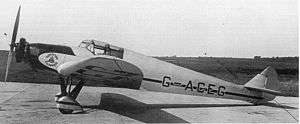Spartan Clipper
The Spartan Clipper was a British light touring aeroplane of the 1930s. It was a single-engine, two-seat, low-wing monoplane with a fixed tailwheel undercarriage.
| Clipper | |
|---|---|
 | |
| Role | Civil touring aeroplane |
| Manufacturer | Spartan Aircraft Limited |
| Designer | H.E. Broadsmith |
| First flight | 14 December 1932 |
| Retired | Destroyed 4 May 1942 |
| Primary user | Spartan Aircraft Limited |
| Produced | 1932 |
| Number built | 1 |
Development
H.E. Broadsmith designed the Clipper as a two-seater; he employed the outer wings of the Monospar ST-4. Spartan Aircraft Limited built one example at their East Cowes works in 1932. The aeroplane was initially fitted with a 75-hp Pobjoy R motor. Registered G-ACEG it flew for the first time on 14 December 1932. After modification to undercarriage, cabin glazing and cowling, it received a Certificate of Airworthiness on 29 June 1933.
In 1933 the Clipper was raced in the King's Cup Race.
In 1938, it was re-engined with a Pobjoy Niagara III of 90-hp, after which it was used as a company hack until 4 May 1942, when it was destroyed in an air raid on Cowes.
Specifications (S.5)
Data from British Civil Aircraft since 1919, Volume 3 [1]
General characteristics
- Crew: 2
- Length: 28 ft 2 in (8.58 m)
- Wingspan: 34 ft 0 in (10.36 m)
- Height: ()
- Wing area: 150 ft²[2] (13.94 m²)
- Empty weight: 770 lb (350 kg)
- Loaded weight: 1,300 lb (591 kg)
- Powerplant: 1 × Pobjoy R, 75 hp (56 kW)
Performance
- Maximum speed: 110 mph[2] (96 knots, 177 km/h)
- Rate of climb: 800 ft/min[2] (4.1 m/s)
References
| Wikimedia Commons has media related to Spartan Clipper. |
- Jackson, A.J. (1974). British Civil Aircraft since 1919, Volume 3. Putnam.
- London 1998, p. 338.